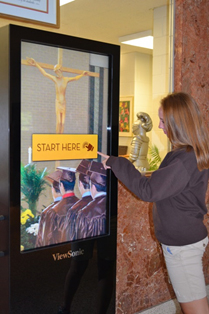As the prevalence of digital signage continues to grow in most public places, churches, mosques, temples, synagogues, and other religious buildings are embracing the technology to improve communication with congregations. Whether the goal is to engage the wider community with outdoor signage or encourage audience participation by broadcasting the words to the daily hymn, religious signs are becoming an integral part of overall communications.
Considering adding digital worship signs to your own religious institution? Answering these questions will help guide your decision on how digital signage can generate the most participation and engagement from your community.
1. How will you pay for the up-front cost?
The majority of places of worship operate as non-profits. That means no matter how generous the members of the congregation, budgets are usually both tight and highly scrutinized. Digital signage is a smart investment but getting the budget committee or temple leadership to sign off on the up-front expense can be a challenge.
Some options to offset the cost include a specific fundraiser for the new signs or selling a sponsorship. The same breakfast restaurant that advertises in the printed circular may be interested in sponsoring the entire new signage system in exchange for some promotional slides being shown at the end of services.
2. What’s the most effective way to place and use the signage?
Agreeing on and securing funding for digital signage is just the first step. Deciding which types of signage should be placed where is a major undertaking, especially for religious leaders who are much more experienced in personal communications than planning visual communication systems. Working with a visual communications partner is the safest bet for religious institutions to get the most out of their investment in digital signage. Answer the following questions within your organization before working with a professional:

- What are the goals of the signage (to educate, to encourage participation, to promote fundraising)?
- What problems have the congregation brought to your attention that could be solved with digital signage (difficulty seeing the rituals, not knowing when or where classes are held, etc.)?
- What are the main areas you would like to improve with digital communications (the outdoor signage, signage around the stage, wayfinding signage in entryways, etc.)?
3. Who’s the Content Boss?
Once the signage is in place someone has to be the point person on keeping the messaging up-to-date in order to get the most out of your investment. Many organizations make the mistake of having this be everyone and no one’s job. This leads to outdated information, confusion and a sense that the new technology has made it harder rather than easier on everyone.
Options for this position might include a church administrator, a tech-savvy volunteer from the congregation or the director of communications in a larger institution. The key is to identify this person before the signs are even ordered and have them work with the digital signage company during installation to understand how the system works.
4. How will the signage be presented to the community?
In institutions where traditionalism and routine are often highly valued, it’s important to think through how religious leaders will introduce the new signage to members. It may be very jarring for someone to walk into the same building they’ve entered weekly for 40 years and be greeted by a brand-new flashing screen. Discuss the changes with the community in advance, address any concerns and be sure to highlight what problems the organization hopes to solve with digital signage. For example, a church circular may announce the coming signage and explain that it will help the older members of the community see the priest more clearly from the back of the church and help parents know which teacher is running Sunday School that week.
If digital signage is part of a larger renovation it will feel more seamless with the other updated surroundings, but don’t skip taking the time to point out the new functionality to the assembly. While some traditionalists may not warm to the signage immediately, on the other end of the spectrum a modern, streamlined look can help attract new, younger members to the flock.
Not all places of worship will have the same needs for religious signage. Work with a visual communications professional and your leadership team to decide what form of digital signage will best suit the goals you have for your institution.